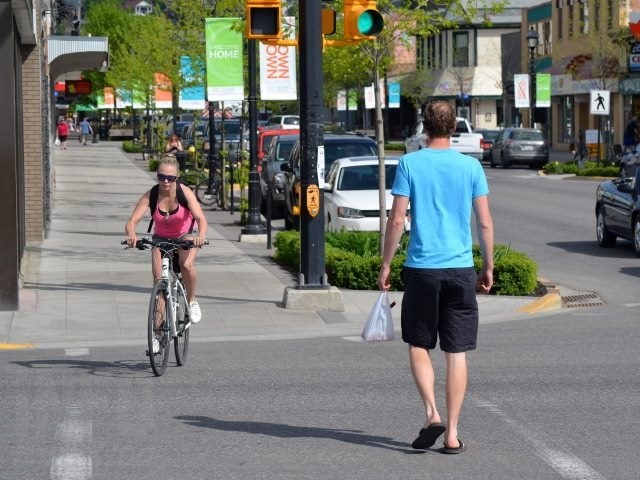
(CHARLOTTE HELSTON / iNFOnews.ca)
September 04, 2022 - 11:00 AM
There’s lots of talk about the benefits of cycling in terms of fitness and getting cars off the road.
But much of the discussion in Kamloops and the Okanagan is about creating safer cycling routes and paths.
What’s not talked about so much is the business case for having bicycles not only having protected lanes on city streets but also on-street parking spots.
While businesses may find the idea abhorrent, studies dating back more than a decade – and real-life experience in places like downtown Vancouver – show that resistance is bad for business.
“Most of the car traffic doesn’t actually visit the businesses but often they are driving through the neighbourhood,” Navdeep Chhina, director of campaigns and inclusion for HUB Cycling in Vancouver, told iNFOnews.ca. “People walking or cycling are actually, most of the time, going to that neighbourhood. Most of the time people walk or cycle when a trip is less than three to five kilometres.”
In 2010, the City of Vancouver started work on a protected bike lane along Hornby Street in the heart of its downtown core, much to the chagrin and strong opposition from businesses, led by the Downtown Vancouver Business Improvement Association.
Five years later, they changed their attitude to one of support for cycling and, starting in 2017, they've been an annual “platinum sponsor” of HUB Cycling, contributing $15,000 a year to the non-profit cycling advocacy group.
The economic benefits of cycling for businesses has been studied globally.
A 2010 study called: 'Recognising the economic role of bikes: sharing parking in Lygon Street, Carlton' demonstrated the economic benefits of switching over street parking spaces for bikes.
“Car users averaged more overall spending per hour than bike riders,” the study found. “However, the small area of public space required for bike parking means that each square metre allocated to bike parking generated $31 per hour, compared to $6 generated for each square metre used for a car parking space.”
Carlton is a small suburb of Melbourne, Australia with a population in 2021 of 16,000. Lygon Street is an Italian restaurant district stretching for a few blocks.
Researchers talked to people on the street about how long they were in the shopping district and how much they spent with local businesses during their time there to reach these results.
The first protected bike lanes in North America were built on 9 Avenue in New York City, between between 23 and 32 streets, in Manhattan, according to a 2012 study called: 'Measuring the Street: New Metrics for 21st Century Streets.'
READ MORE: Why Penticton’s lake-to-lake bike route may be delayed
It found that the bike lanes not only resulted in a 35-58% decrease in injuries to all street users (depending on location) but also a 49% increase in retail sales.
There are numerous other studies out of places like Victoria, Toronto, San Francisco and Portland.
How Bike Lanes Benefit Businesses was a 2018 study done in Akron, Ohio. It noted that people walk greater distances to stores in shopping malls than if they have to park 150-300 feet away from a business on a city street.
“We’re talking about a difference of a 30- or 60-second walk when we compare a front door parking spot with a parking spot just down the street,” the report says. “What’s more, during that walk, customers will pass by other businesses on Kenmore and see them up close instead of viewing them through a fast-moving car window. This benefits everyone.”
Kenmore Boulevard was being redesigned at the time the report was done. It was written by Rachel Quednau, Program Director for Strong Towns, a U.S. non-profit organization “helping communities become financially strong and resilient,” her website says.
As far as HUB Cycling’s Chhina is concerned, the business case for increasing cycle paths and parking has long been made.
“The challenge, now, is finding the dollars to implement this,” he said.
His group is working with Translink to build “cycle highways” between urban centres and encouraging safer crossings, such as having cycle-sensitive traffic lights that are triggered when a group of cyclists approach an intersection so they’re not forced to stop for a red light.
READ MORE: Sicamous to Armstrong rail trail gets $12.5M grant, but millions still needed
HUB is also lobbying provincial and federal governments to commit long-term, stable funding to build cycling infrastructure and have active transportation a part of not only road designs, but as an integral part of building designs.
It's essential, Chhina said, that cycle routes offer complete connections and are not done piecemeal.
“The idea is not to remove cars at all but, rather to build a complete street, where people who need to use their cars have access to parking spots and access to the businesses but also, so people can safely walk or cycle to support urban businesses.”
To contact a reporter for this story, email Rob Munro or call 250-808-0143 or email the editor. You can also submit photos, videos or news tips to the newsroom and be entered to win a monthly prize draw.
We welcome your comments and opinions on our stories but play nice. We won't censor or delete comments unless they contain off-topic statements or links, unnecessary vulgarity, false facts, spam or obviously fake profiles. If you have any concerns about what you see in comments, email the editor in the link above.
News from © iNFOnews, 2022